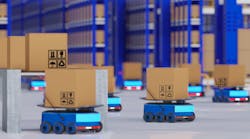RaaS for Mobile Robotics in Logistics Accounts for 6-8% of Market Revenues
RaaS is becoming an increasingly popular option, especially for mobile robotics in logistics. The benefits of using this business model which allows a company to lease robotic devices and access a cloud-based subscription service, growing. A report " Moblie Robotics in Logistics, Warehousing and Delivery 2022-2042", by IDTechEx, found that 6-8% of the current market revenue for mobile robotics in logistics comes from RaaS model. And this number is expected to grow.
Intralogistics material transporting robots, like AGVs and AMRs, dominate the biggest share of the logistic mobile robotics market.
The report describes the three biggest advantages of choosing RaaS for adopting mobile robots in warehouses.
Low cost of entry
Even though the upfront cost of implementing mobile robots is usually much less than that of installing complex fixed automation systems, some small and medium-sized enterprises may not be able to afford to complete the system initialization of mobile robotics at once. For instance, to fully automate the "goods-to-person" process in a 5000m2 warehouse, 200 grid-based automated guided carts (AGCs) could be needed, and the installation cost can be $4-4.5 million if software and customized shelves are also counted in. However, like all X-as-a-Service models, the billing of RaaS can be based on a monthly subscription or a pay-as-you-go model. In this case, customers can utilize the service without investing too much at the beginning and will have fewer losses if they stop operating the mobile robotic system.
Flexibility
In many industries, agile and lean operations are always desired; companies should be able to change operations or productions rapidly in response to market changes. RaaS allows customers to start or end mobile robotic systems at any time point as needed, and also allows changing product types quickly, for example, transferring from "shelve-to-person" grid-based AGCs to "carton-to-person" case picking robots easily.
Scalability
As described in the report scalability is one of the most important strengths compared to fixed automation. However, RaaS enables scaling the fleet size to be even more convenient and easier, without concerning about the risks of reducing the fleet size in the future. For example, at sales peaks (e.g., Black Friday and other shopping festivals) temporary workers are often needed in warehouses to fulfill the surged demand. However, due to the global labor shortage, recruitment for temporary positions has become very challenging. RaaS of mobile robots can address this issue cost-effectively by expanding the service size to increase capacity and productivity for only a short period of time.
In the meanwhile, RaaS may bring benefits to mobile robotics companies as well. RaaS help increase customer stickiness by continuously providing service to customers, potentially creating more values and opportunities in the long term. It also helps maintain a good relationship with customers, making marketing and promotion easier for new products. Furthermore, companies can receive direct feedback from customers by providing RaaS to improve and accelerate product development.
